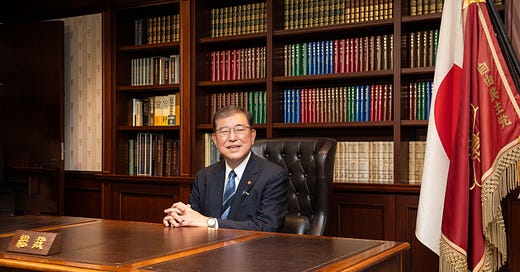Thank you for reading Observing Japan. This post is available to paid subscribers.
If you are looking for timely, forward-looking analysis of the stories in Japans’s politics and policymaking that move markets, I have launched a new service through my business, Japan Foresight LLC. For more information about Japan Foresight’s services or for information on how to sign up for a trial or schedule a briefing, please visit our website or reach out to me.
Readers can also find my views on the LDP race in the following articles:
Alastair Gale and Yuki Hagiwara, “‘Asian NATO’ Backer Ishiba to Become Japan PM as Race Jolts Yen,” Bloomberg
Motoko Rich and Hisako Ueno, “Japan’s Governing Party Selects New Prime Minister,” New York Times
Justin McCurry, “Japan’s ruling party picks Shigeru Ishiba to become next PM,” The Guardian
William Gallo, “Shigeru Ishiba to become Japan’s next PM,” Voice of America
I was also interviewed by the Asahi Shimbun before the voting, which is available here.
The Ishiba Shigeru era began suddenly, as the reformist finally secured the Liberal Democratic Party’s (LDP) leadership on his fifth try in dramatic fashion. Despite his public popularity, Ishiba’s victory seemed like the least likely outcome of the three top-tier candidates, particularly after Takaichi finished with a sizable first round lead.
Now, with the LDP election behind us, we can begin thinking about what the election and its aftermath mean for the distribution of power within the LDP and between the LDP and other parties.
How Ishiba won
While there will be more reporting to come about the maneuvering that delivered the premiership to Ishiba, Nikkei describes Ishiba’s winning coalition as an effective pact between outgoing Prime Minister Kishida Fumio and his predecessor Suga Yoshihide, who, despite their own rivalry, saw Ishiba as more amenable to their interests (for Kishida, defending his policy legacy, for Suga advancing political reform) than the Asō- and former Abe faction-backed Takaichi Sanae. As anticipated, each of the seven runners up functioned as a quasi-faction, groups that were the building blocks for a second-round winning coalition. In Ishiba’s case, to the forty-six votes he received from lawmakers in the first round he could add Koizumi Shinjirō (75) and Hayashi Yoshimasa (38), which together would account for all but thirty of the 189 lawmaker votes he received in the second round. For the remainder he may have been able to draw from Kamikawa Yōko (23) – close to Kishida but also having nine Asō faction members among her endorsers – and Katō Katsunobu (16), close with Suga. In fact, Kamikawa’s support minus the nine Asō faction members plus Katō’s support would be enough to reach the 189 votes that Ishiba received.
While in hindsight this winning coalition seems obvious, his twenty-one vote margin of victory – clearing the 208 votes needed for a majority by only seven – was a close run thing, and it required extraordinary discipline to hold together, for example Koizumi’s seventy-five-member bloc. Katō, after all, could not even retain his twenty endorsers when the voting started, as he fell five short of what should have been the minimum in the first round.1 Suga will receive much of the credit, but it does seem that in the end, Kishida Fumio stepped into his own as a kingmaker. The Asahi Shimbun points to the roles played by both Suga – who kept Koizumi’s bloc together – and Kishida in helping Ishiba close the gap with Takaichi. This outcome is particularly ironic given that Kishida first won the premiership by joining ranks with Takaichi to defeat the Suga-backed Kōno Tarō in 2021.
Keep reading with a 7-day free trial
Subscribe to Observing Japan to keep reading this post and get 7 days of free access to the full post archives.




